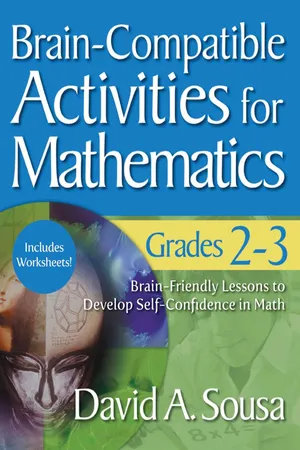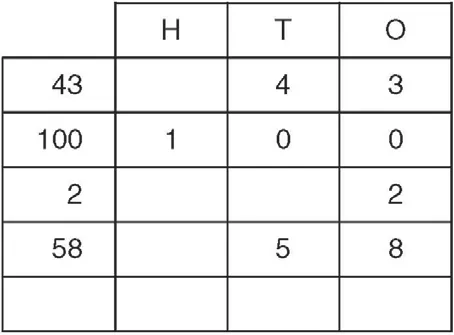![]()
1
Base-Ten and Place Value
Jumping Jelly Beans
Hundred Board-O
Order Up!
Number Neighborhood
Stretching Numbers
Place Value Pause
Place Value Bingo
JUMPING JELLYBEANS
Objectives
Students will recognize number patterns in the base-ten numeration system.
Students will use jellybeans to practice counting by tens.
Anticipatory Set
Place a large jar of multicolored jellybeans on your desk or in another widely viewed location. Then invite students to count with you to 100, first by ones and then by twos, fives, and tens. Ask students which method of counting is the slowest (counting by ones) and which is the fastest (counting by tens).
Arithmetic and mathematical knowledge should be based first on concrete situations rather than abstract concepts.
Purpose
Tell students that they will look for patterns on a hundred board. The patterns that they discover will help them to see how numbers are arranged to show different values. Explain that when you understand the patterns, you can group numbers together to count items faster.
Input
Copy the Hundred Board reproducible onto an overhead transparency, and give each student a photocopy. Point out how the 10 numerals along the top row are repeated over and over again throughout the board. Guide students to point out various patterns that they find on the board. For example, in the column under 10, every number ends in 0. Have students count by tens to 100 again, this time pointing to the numbers on the board as they go along.
Modeling
Show students the jellybean jar. Tell them. “I want to know exactly how many jellybeans are in this jar, but to count them all by myself would take a long time. How might we be able to work together to count these jellybeans?” Allow several students to respond, and then explain that you want them to help you put the jellybeans into groups of 10 so you can count them quickly.
Show students a small paper cup and count aloud as you place 10 jellybeans in the cup. Count out 10 more jellybeans and place them in a separate cup. Say, “There are 10 jellybeans in each cup. I can count by tens, and I know that I have 20 jellybeans so far. You will work in pairs to make sets of jellybeans just like these. Then we can all count by tens together to see how many jellybeans we have in all.”
Guided Practice
Organize students into 10 small groups or pairs. Give each group 10 small paper cups and 1 large cup filled with jellybeans. Instruct students to count out 10 jellybeans and place them in 1 cup.
Checking for Understanding
Check to make sure that each group has one cup with 10 jellybeans in it. Ask how many jellybeans should be in each cup (10).
Independent Practice
Ask groups to finish counting out the rest of their jellybeans in sets of 10. Circulate and monitor student work and interactions. When all the jellybeans have been counted, ask each group to count by tens to show how many jellybeans they have. Jellybeans that could not be grouped in a set of tens should be counted as ones. Invite a student from each group to use an overhead marker to color the box on the hundred board transparency that matches the number of jellybeans for the group.
Closure
Have groups collect their cups of jellybeans and bring them to a table at the front of the room. Combine all of the single jellybeans into one bowl and have volunteers create sets of 10 with them. Then have students arrange the cups into groups of 10 while counting aloud to 100. Ask, “How many groups of 10 does it take to make 100? How many sets of 100 would it take to make 1,000?” Using the sets of cups as a model, count by hundreds to determine how many jellybeans there are in all. Have students draw pictures in their math journals to show how the jellybeans were grouped and counted.
HUNDRED BOARD-O
Objective
Students will use their knowledge of place value to identify numbers on a hundred board.
Anticipatory Set
Ask students to describe various types of Bingo games that they have played. For example, they may have played Bingo games that used rhyming words, synonyms and antonyms, or addition and subtraction facts. Display a transparency of the Hundred Board reproducible on the overhead projector. Tell students that they will play a Bingo game using numbers and place value.
Charts in different arrangements (e.g., 1 to 100) offer many opportunities for students to explore number patterns.
Purpose
Explain to students that each digit in a number has a specific value based on its place within that number. This is called place value. The Bingo game that students will play will help them practice identifying numbers by listening to descriptions of place values.
Input
Draw a place value chart on the board with spaces for hundreds, tens, and ones. Write the numbers 43, 100, 2, and 58 in a column next to the chart. Fill in the place value chart for the number 43 by writing 4 in the tens column and 3 in the ones column. Explain that the 4 is worth 4 tens, or 40. The 3 is worth 3 ones. Say, “40 + 3 = 43.” Ask volunteers to fill in the chart for the remaining numbers.
Modeling
Tell students that as they play this game, you will call out numbers in terms of their place value. Choose a number, such as 56, and say, “5 tens and 6 ones.” Use your overhead transparency of the Hundred Board and cover the square for 56. Explain that 56 is the same as 5 tens and 6 ones. Point out how the number 5 is in the tens place and the number 6 is in the ones place. Repeat with several more numbers.
Guided Practice
Give each student two copies of the Hundred Board reproducible and several paper squares. Have students cut apart one Hundred Board into separate number squares and place the squares in a paper bag. Organize students into pairs, and explain that each pair will play its own game. Tell students to choose one player to go first. Player 1 draws a number square from his or her bag and describes the number using place value, such as, “3 tens and 1 one.” Player 2 then finds the matching number on his or her Hundred Board and covers it with a paper square. Players then switch roles. Tell students that they will continue playing in this manner until one player has an ent...

